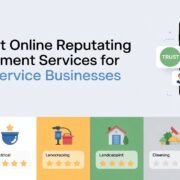Introduction to Enterprise Application Platforms (EAPs)
In today’s fast-paced business environment, organizations continually seek ways to enhance performance and adapt to ever-evolving market demands. Enter Enterprise Application Platforms (EAPs)—powerful tools designed to streamline operations and facilitate seamless integration of various software applications within an organization. Imagine a world where your teams can collaborate effortlessly, processes run like clockwork, and data security is fortified at every turn. Sounds appealing, right? EAPs offer not just solutions but a transformative approach for businesses aiming to thrive in the digital landscape. Let’s dive into how implementing an EAP can revolutionize your organization from the inside out.
Understanding the Role of EAPs in Organisations
Enterprise Application Platforms (EAPs) serve as the backbone for many organizations, unifying various software applications into a cohesive system. They simplify complex processes and help streamline operations. By integrating diverse functionalities—such as data management, customer relationship management, and workflow automation—EAPs enable teams to work more effectively. This interconnectedness fosters collaboration across departments. Moreover, EAPs empower businesses with real-time insights through dashboards and analytics tools. Decision-makers gain valuable information quickly, allowing them to respond proactively to market changes or internal challenges. As technology evolves rapidly, organizations must adapt swiftly. EAPs provide the agility needed for companies to scale their operations while maintaining efficiency. In this digital age, adopting an EAP can be a strategic advantage that sets businesses apart from their competitors.
The Top 5 Benefits of Implementing an EAP for Your Organisation
Increased efficiency and productivity are game-changers for any organization. An Enterprise Application Platform (EAP) automates repetitive tasks, allowing employees to focus on more strategic initiatives.
Increased Efficiency and Productivity
One of the standout advantages of an Enterprise Application Platform is its capacity to boost efficiency and productivity. By integrating various applications into a single framework, teams spend less time navigating multiple systems. Streamlined workflows become a reality. Manual tasks that, once consumed hours, can be automated, allowing employees to focus on more strategic initiatives. This shift not only enhances individual output but also improves overall team performance. Moreover, real-time data access enables swift decision-making. Employees have access to valuable insights, allowing them to respond more quickly to changing circumstances or customer needs.
Streamlined Communication and Collaboration
Effective communication is the backbone of any thriving organization. An Enterprise Application Platform (EAP) brings teams together by centralizing information and tools in one accessible location. With integrated messaging, video conferencing, and project management features, EAPs eliminate silos that often hinder collaboration. Employees can share ideas seamlessly, regardless of their physical location. Real-time updates keep everyone informed about project progress and changes. This transparency fosters a culture of teamwork where all members value input.
Cost Savings and ROI
Implementing an Enterprise Application Platform (EAP) can significantly reduce operational costs. By centralizing various processes, organizations minimize the need for multiple software solutions, which often come with hefty license fees. Moreover, EAPs automate routine tasks that once required extensive manual labor. This leads to faster turnaround times and less reliance on human resources for repetitive functions. The return on investment becomes clear as companies streamline their workflows and enhance productivity. An efficient platform allows teams to focus more on strategic initiatives rather than getting bogged down by administrative duties.
Scalability and Flexibility
Scalability and flexibility are two cornerstone features of an effective Enterprise Application Platform (EAP). As your organization grows, demands change. An EAP allows you to adapt seamlessly without having to overhaul your entire system. With scalable solutions, you can quickly increase resources or expand capabilities. This means handling higher workloads becomes a breeze as business needs evolve. Flexibility goes hand-in-hand with scalability. Organizations can integrate new tools or applications tailored to specific requirements. Whether it’s adding functionalities for different departments or adapting to market trends, an EAP enables quick adjustments.
Enhanced Data Security and Compliance
Data security is more critical than ever in today’s digital landscape. An Enterprise Application Platform (EAP) provides robust security features that protect sensitive information from unauthorized access. With advanced encryption methods and secure authentication protocols, EAPs reduce the risk of data breaches. They offer organizations peace of mind knowing their customer and business data is safeguarded. Compliance with industry regulations can be daunting. EAPs help streamline this process by automating compliance reporting and ensuring adherence to standards like GDPR or HIPAA. This minimizes the chances of costly penalties.
Key Considerations When Choosing an EAP for Your Organization
Choosing the right Enterprise Application Platform requires careful thought. Start by assessing your organization’s unique needs. Identify specific pain points that an EAP can address. Next, consider integration capabilities. The platform should seamlessly connect with existing systems and software to ensure smooth operations across departments. User experience also plays a vital role. A user-friendly interface encourages team adoption and minimizes training time. Don’t overlook scalability. As your organization grows, the EAP should adapt without requiring significant overhauls or additional investments. Finally, evaluate support and maintenance options provided by vendors. Reliable customer service is essential for troubleshooting issues quickly and ensuring uninterrupted business processes throughout their lifecycle.
Conclusion
Implementing an enterprise application platform is not just a technological upgrade; it’s a strategic move that can transform your organization. As businesses face increasing competition and the need for efficiency, EAPs emerge as vital tools to streamline operations and enhance collaboration. Organizations that embrace EAPs often see substantial productivity improvements. By automating processes and integrating various applications, teams can focus on what truly matters—innovation and customer satisfaction. Moreover, with the flexibility of scalability offered by these platforms, companies can adapt quickly to market changes without significant disruptions. This adaptability allows organizations to stay ahead of their competitors and respond effectively to evolving customer needs. Considering all these advantages, it’s clear that adopting an enterprise application platform is not only beneficial but also essential for modern organizations seeking to thrive in a digital landscape. The right EAP can be a game changer, driving growth while simplifying operational complexities across all departments. Embracing this technology can set your business up for sustained success in today’s dynamic environment.













